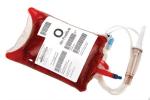|
This section contains 1,197 words (approx. 4 pages at 300 words per page) |

|
The life fluid of the body is blood. All animals, including humans, require that nutrients and oxygen be available for metabolism and that wastes be removed. In animals that measure 1 millimeter or less in diameter, these substances are transported within the body by diffusion between the cells and nearby body parts. In larger, more complex animals, circulatory systems have evolved with arteries, veins, and capillaries to transport respiratory gases, nutrients, waste products, hormones, antibodies, and salts to parts of the body.
Blood, the medium for transporting nutrients and waste products, is both a tissue and a fluid containing many specialized types of cells. It is a tissue because it is a collection of similar cells that serve a particular function. These cells are suspended in a liquid matrix called plasma, which allows the blood to act as a fluid.
Blood plays an important role in nearly all body...
|
This section contains 1,197 words (approx. 4 pages at 300 words per page) |

|


